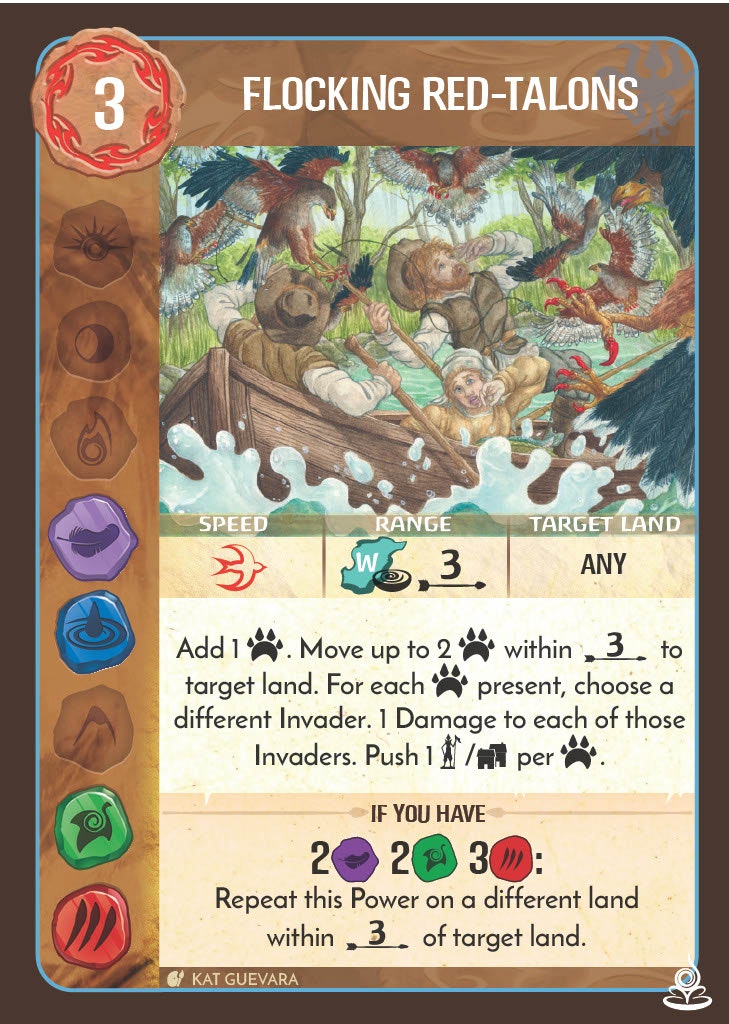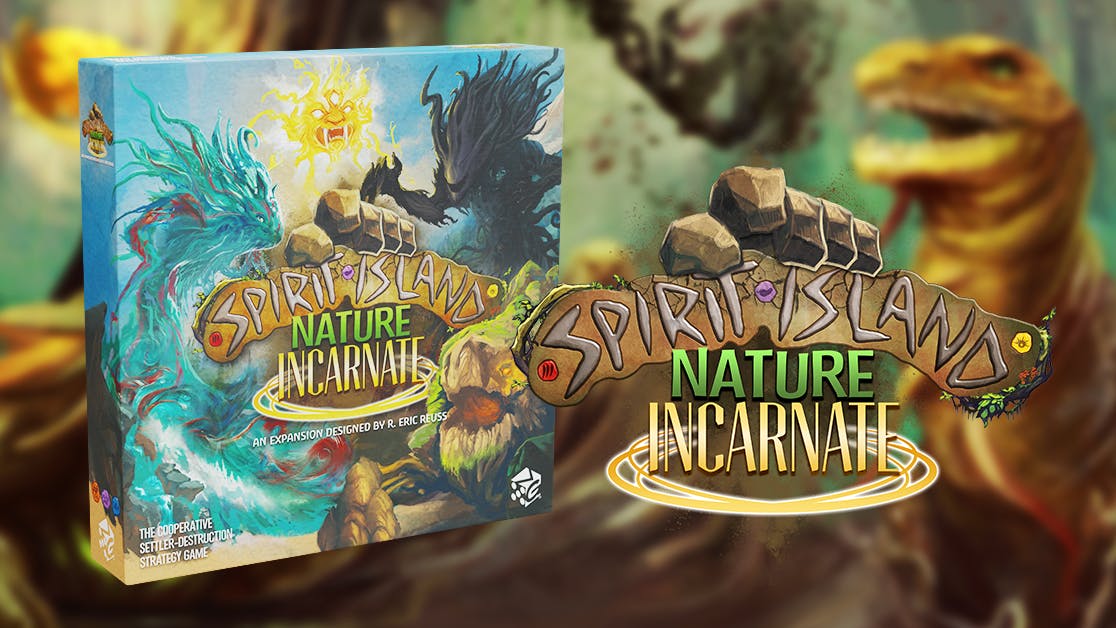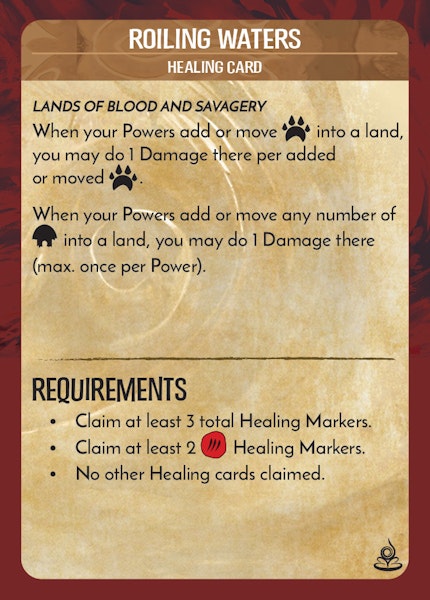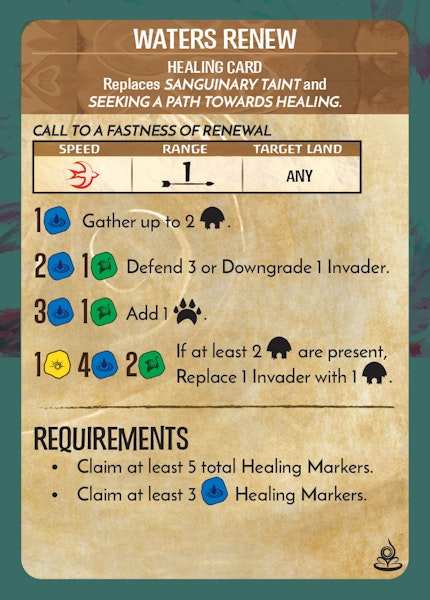Project Update: Final Spirit Reveal: Wounded Waters Bleeding
Hello to our 10,869 backers! Here it is, the final Spirit. We’ve had 467 of you join since we last had an update and we’ve saved one of the best for last for all of you to enjoy. There’s no real best of course, but this complicated Spirit offers so much in both terms of theme and gameplay complexity.
The creator of Spirit Island R. Eric Reuss and development team member Ted Vessenes write more about this incredible spirit with our final bonus card for this campaign. Gentlemen, please tell us all about Wounded Waters Bleeding.
The creator of Spirit Island R. Eric Reuss and development team member Ted Vessenes write more about this incredible spirit with our final bonus card for this campaign. Gentlemen, please tell us all about Wounded Waters Bleeding.
Story
In years and generations past, there was a small lake (or a large pond, depending on how you looked at it) nestled into a wooded area. It was fed by a large brook (or a small river) that ran its way down a rocky slope, producing a bit of spray and a pleasing burbling noise.
You might expect that animals would come to the lake to drink, and you would be more right than you knew - for the pool was (or was the home of, again depending on how you looked at it) Peace-Waters, a Spirit of contented co-existence and the gift of water. On its banks, predators did not hunt prey, and a curious feeling of peace spread through all who approached.
(Do you wonder to yourself how the ecosystem survived such a thing? The protections of Peace-Waters only applied to guests, to animals visiting for water, not to those which lived within the waters itself. Any animal or human which came to drink would, after finding enough inner peace to lose track of time's passage, feel an urge to move onwards - prey animals could drink without fear, but predators could do quite well for themselves on the game-paths leading to and from Peace-Waters, so long as they were far enough away.)
Then the Invaders came. Some of their explorers found Peace-Waters' lake, and in keeping with the nature of the place, decided it didn't feel quite right to site a mill there. But upstream... upstream of Peace-Waters, they settled, and built slaughterhouses and tanneries. With death’s blood and worse pouring into the pool day after day, Peace-Waters started to change.
They are - for now - still a Spirit of water and water's gift, but half-transformed to a Spirit of blood, predation, and wracking taint. Caught between these two deeply opposed natures, they are slowly disintegrating, trying to find coherence before dissolving completely.

Design
Wounded Waters Bleeding is a great example of how initial design ping-pongs between the elemental and the thematic and the mechanical, with experience hovering over the whole thing.
The initial prompt which eventually led to Wounded Waters Bleeding was “Hmm, what might a Water + Animal Spirit look like?”.
As a first step, I reviewed the Water, Animal, and (especially) Water+Animal Minor Powers to get a sense for the types of resonances baked into those elements. (This is a pretty standard step for any Spirit, once I have an idea of its elemental portfolio. Having some cards that don’t match up quite right is fine, but if there’s a major conflict between its concept and what it’s likely to want to pick elementally, that’s a big warning flag.)
What I found in this case was a deep conflict - some of the powers were extremely life-affirming, like Teeming Rivers or Call to Tend, while others like Fleshrot Fever or Blood Calls Predators were very much about death.
I could have chosen to focus on just one of those, and leaned towards Water or Animal (which correlate somewhat with those tendencies) - and/or included other structures in the Spirit’s rules which would pull it in one direction or the other. But I found the dichotomy really thematically interesting, and after some thought decided to move forward with it as a choice the Spirit itself faced.
(I’ve mentioned before that “how will you (the Spirits) change?” is one of the secondary themes of Spirit Island. This is usually represented via what Power Cards a Spirit gains and Forgets, but sometimes it will be more front and center in a design, like Starlight Seeks Its Form or Relentless Gaze of the Sun. Wounded Waters Bleeding is another one about change, and here, the question is much more “how will you change to survive?”)
From this came the core concept of a wounded, bloodied Spirit trying to find coherence in a new nature. I liked it not just for the resonances of element and change already mentioned, but because it showed a new facet of the Invaders damaging the island: they weren’t just obliterating, they were also transforming in destructive ways. It tied nicely into the truth (of both game and real life) that messing with the environment can come back to bite you, and also to the in-game belief of the Dahan that wounding a Spirit without destroying it will let it grow back stronger than before.
So, then, how to implement it?
Getting “wounded” across seemed like it wanted effects during gameplay - simply “starting with some destroyed Presence” wouldn’t have the same oomph - and the most obvious way was “lose a Presence every turn”.
Not only is losing Presence an obvious sign of a Spirit getting hurt, but it tends to have a bigger feel-impact than mechanical-impact. Having it happen every turn would evoke echoes of the desperation the Spirit itself would be feeling - though it needed to be clear to the player that the Spirit wasn’t going to just implode, that it had the ability to find a new stability before it ran out of Presence. (Early versions had an Energy-costing costing Growth choice to add Destroyed Presence, which was usually an obviously bad move but acted as a security blanket - “OK, this is here if I ever really need it”.)
For “finding stability in a new nature”, I settled on having two innates - one Water-primary, one Animal-primary - each of which could replace the other one, permanently shifting the Spirit’s elemental affinity. The replacement innates leaned more strongly towards the extremes of “life” and “death” than the on-panel innates, so after healing you’d end up with one on-panel innate that still had echoes of being wounded (“healing” is “finding a new way forward”, not “all is now exactly as it was”) and a new innate that was more focused on its new nature. This let the two healed states feel very different from each other.
As it turned out, structuring the healing via Innates brought with it some intrinsic problems that required a very late redesign; the dev notes will go more into that. The final version still lets you replace innates, to a very similar effect, but via a completely different means.

The Spirit comes with 4 Healing Cards - here’s two of them:
Two of the Healing Cards can be played Turn 3 and grant a Special Rule; the other two can be played Turn 5 and replace one Innate Power (as well as stopping ongoing Presence loss).
The dev notes talk more about how those work, as well as a bunch of other things! But before I hand it over, I just want to note that the way you handle gaining 0 Energy/turn for multiple turns is that you start with some Energy - see the panel back above. (And this “spending a resource you’re not getting more of” also contributes to the feeling of being wounded, while giving you enough Energy that you’d have to work at it to run out before reaching a better income.)
Dev Notes, by Ted Vessenes
Along with Relentless Gaze of the Sun and Dances Up Earthquakes, Wounded Waters Bleeding was the third Spirit of Eric’s original six that I thought we could plausibly include in this expansion. One of these had a blight adding death laser innate, another was the precise definition of very high complexity (players must plan multiple turns in advance), and Wounded Waters forced players to destroy their presence every turn. That is quite an intimidating set of Spirits to refine! For a long time I thought we couldn’t make Wounded Waters work, which is why I asked Eric to design a control spirit (which turned into Wandering Voice Keens Delirium).
The core idea behind Wounded Waters was always the same: it’s a Spirit with a conflicted, split sense of identity. This slowly destroys the Spirit until it can reconcile its nature, healing one way or the other. Originally the Spirit had two simple heals (one for water, one for animal), which were triggered by hitting mid-game 4-2-1 element thresholds. When you healed for one side, you traded in your other base innate for a different innate with more aligned elements. This also stopped future presence loss. The intent was that players would have to work to heal sometime in the mid-game, and that it would sometimes be a niche strategy to avoid healing for the entire game.
The first thing I noted was that this Spirit needed a special rule to tie together the water and animal strategies. Generally speaking, Spirits are most interesting when they give players reasons to care about power card drafts besides the elements. For example, Ocean likes all cards that move invaders, even those without Water. Wounded Waters needed a special rule that gave players mechanical direction, and it needed to contribute to both the water and animal strategies, because you want those early game effects to stay relevant even when your innate powers shift. We tried some variants around beasts and disease tokens, until we eventually settled on dealing 1 damage when you moved invaders/Dahan/beasts. This worked because the Water side focused on piece movement and the Animal side focused on damage.
As for the healing mechanic, this was a great example of how intent in game design isn’t as important as how players actually want to play. In testing, we saw that nearly every player tried as hard as possible to heal as soon as possible. Our target heal turn was “5 or 6, or maybe 4 if you stretch”. Testers felt that the spirit absolutely had to heal by turn 4, or it was too weak. Some testers would try to get enough elemental support to heal on turn 3 or even 2. We tried weakening the value of healing and strengthening the spirit pre-heal, such that the relative benefit was a lot smaller. But none of that changed the perspective that healing immediately was a priority. It only made players unhappy with the payoff for going through that much work, even if healing a turn later would have been easier.
Relatively late in the dev process, the Spirit was clocking in at Very High complexity, and playtesters just weren’t as excited about the Spirit. Eric took the Spirit back in the shop and came up with a different take on the healing mechanic. Each turn, Wounded Waters gains a healing marker associated with whichever element it has the most of. And when you have enough healing markers of the right type, you heal your Spirit, trading your water innate for a new animal innate (or vice versa). This let us precisely control which turn the Spirit heals on, so players could focus on what they wanted the Spirit to do instead of healing quickly. Initial tests showed this was a step in the right direction, but the healing mechanic was still too complicated. And the play dynamics shifted too much in the mid-game.
I took this idea and ran with it. To simplify things, I made 5 healing cards instead of the original 3. Three of the healing cards gave you a different special rule and two of them changed your innates. They were structured such that you would eventually pick one special rule and one innate. As we refined the Spirit, the design settled on two different special rules and two innates, with four possible healing combinations. The special rule heals happen on turn 3, giving players an early game power boost as well as tactical direction. And on turn 5, once Waters has drafted its element identity, it finishes healing with a new innate power. There are four different builds of this Spirit, each with its own unique strategy and strengths.
Because a Spirit’s name changes as its nature changes, we named the healing cards with portions of Wounded Waters Bleeding’s new name. So on turn 3, the spirit becomes either Roiling Waters Bleeding or Serene Waters Bleeding, depending on whether the Spirit leaned more into its water or animal side. On turn 5, Roiling Waters Bleeding will turn into either Roiling Waters Renew or Roiling Waters Taste of Ruin, completing its healing process. This means the Spirit has seven different names.
And that’s where things landed right at the layout deadline! Wounded Waters had four additional healing cards, but otherwise was a pretty normal looking spirit. There’s nothing else interesting about this Spirit, right? Right?
Oh, yeah… That forked presence track.
As the layout deadline loomed, we realized the Spirit had similar balance problems as Wandering Voice and Breath of Darkness had. In particular, too much early control will trivialize the game and too little control makes it impossible. It still had a standard two track layout as well. To solve this, we seriously restricted early access to card plays. But that only resulted in a “one true opening” for the first 3 turns. This frustrated players who wanted flexibility while also being a trap for players who tried the wrong opening.
I negotiated an extra week of time for Wounded Waters and tried a dramatic redesign of the entire presence track. The idea was that if we were going to force players to have the same presence track opening, we should at least be honest about doing that. There are three things I really like about the forked track concept. First, it gave us perfect control over how many card plays the Spirit has on the first three turns, which lets us fine tune the early game strength. Second, it’s very thematic how a wounded Spirit doesn’t have as many choices. And third, when I only had a week to balance the tracks, it’s really helpful to have a highly constrained problem.
I also changed the growth choices such that players must take the second growth for the majority of the game. This is intentional because without gaining power cards, the Spirit can’t move towards any new identity. While it looks like the Spirit has fewer early game choices, the reality is that initial power card drafts are very important. A full 50% of the minor and major power cards are relatively good cards for at least one of the four healing builds, and some of them are downright amazing. What other Spirit is excited to see any of Tigers Hunting, Smothering Infestation, and Irresistible Call? Wounded Waters has been an incredible Spirit to develop, and I think one of our best efforts to date.
Major Power Card: Flocking Red-Talons
Of course there’s also some new major powers that are great for Wounded Waters. Here’s one that’s utterly exceptional for Roiling Waters builds:

Any beast-using Spirit would be happy to take this card as a beast-based control card. But Roiling Waters gets 3 bonus damage just for adding/moving the beasts. Hit the threshold for another 3 damage, in a land up to 6 away from the origin!
—
Thank you both for all the hard work you, and the rest of the development team, have put in for these information filled updates! We’re here, the last heavy update of the campaign. We’ve got one more to go tomorrow with our last celebration of our number of wonderful backers and how we’re going to keep you updated moving forward to bringing this product from us to you.
Oh, and the answer to the little hint all the way back from the dev team interview. That’s right, I didn’t forget because I knew at least one of you out there would remember! Tomorrow, we’ll see you one more time when the campaign is over!
Comments
40



